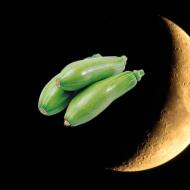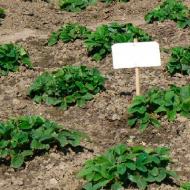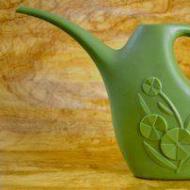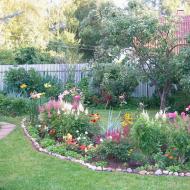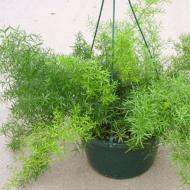
Asparagus flower care at home, transplantation and reproduction. Asparagus home care transplant and reproduction Asparagus home care transplant
Asparagus is a beautiful houseplant valued for its delicate openwork greenery. This air creature is a real miracle of nature. The plant looks especially impressive when bright red fruits appear on fragile branches. Graceful asparagus, reminiscent of lace, will decorate any collection of flowers grown at home. If you think about it, caring for a plant is not that difficult.
Description of the houseplant and its photo
The genus Asparagus unites about 300 species of perennial plants. Africa is considered the homeland, it grows in nature in India, on the Mediterranean coast of Europe, in the Far East. The first image of the plant refers to the 3rd century. BC. Even the ancient Egyptians grew this culture and ate it. After all, asparagus growing in an apartment belongs to the same genus as vegetable asparagus, only to different species. Decorative asparagus began to be grown a little over 100 years ago.

Asparagus is prized for its delicate, lush greenery.
The culture is distinguished by species diversity: it is represented by herbaceous plants, large shrubs or lianas. Characteristic features of asparagus are branched shoots, small flowers, a fruit in the form of a berry, a powerful tuberous root. Most asparagus do not have green leaves, their role is played by flattened needles located in the axils of small scaly leaves.

Ornamental asparagus belongs to the same genus as vegetable asparagus.
With good care, the flower grows up to 40 cm and lives for more than 10 years.
Asparagus adapt well to the conditions of detention, it is not difficult to grow them at home.
Species and names: pinnate, Mayer, Sprenger and others
Asparagus pinnate is a branching subshrub with bare shoots. The leaves are small (0.5 cm) triangular scales. Light green phyllocladia are slightly curved. The flowers are white. The fruit is a black berry.

Curved light green phylloclades of Asparagus pinnata give an openwork appearance to the whole plant.
Asparagus the thinnest is similar to pinnate, but its phylloclades are thinner and longer, rather sparsely located. The length of the shoots is up to 1.5 m. It blooms with white flowers, black fruits.
Asparagus Mayera is a semi-shrub with straight stems up to 60 cm long, strongly pubescent - this feature is characteristic only for this species. Small phylloclades grow close to each other.

Asparagus Mayera differs from other species in strongly pubescent stems.
Asparagus crescent - liana with long thick shoots up to 15 m long. On flexible stems there are numerous crescent-shaped cladodes up to 8 cm long, with corrugated edges. The flowers are white.
Asparagus Sprenger is a herbaceous plant. Stems glabrous, branching, up to 1.5 m long. Leaves in the form of scales 2–4 mm long. Phylloclades up to 3 cm long, straight or slightly curved. The flowers are white or light pink. The fruits are red berries.
Varieties in the photo
Asparagus officinalis contains many useful elements Asparagus asparagus - a climbing shrub that blooms with white flowers Small flowers of asparagus Sprenger are very fragrant Asparagus sickle is distinguished by sickle-shaped cladodes
Variety of asparagus on video
Comfortable growing conditions
| Lighting | Many species of asparagus prefer bright diffused lighting, so it is best to place the flower on the west or east side, protecting it from direct sunlight that causes greenery burns. You can arrange a flower on the north side, but in low light it becomes less decorative, the shoots are strongly drawn out, the phylloclades are sparse on them. In summer, asparagus can be taken out to the balcony, terrace, gradually accustoming it to new conditions after winter. They are placed in partial shade, protected from drafts. |
| Humidity | The plant feels comfortable in a humid microclimate. Dry air can lead to yellowing of the leaves and even to the death of the flower. Therefore, it is necessary to spray asparagus more often. You can leave it overnight in the bathroom after a shower. In winter, the flower should not be kept near heating appliances. |
| Temperature regime | The optimum summer temperature is + 20-25 degrees. Doesn't tolerate extreme heat well. In winter, the room should not be lower than + 12–15 ° С, otherwise the plant will begin to dry out and shed its leaves. |
| Watering | In spring and summer, regular watering is needed, once every 3-4 days. However, the soil must not be waterlogged. Water less often in winter. |
| top dressing | Asparagus is fed weekly in spring and summer, once a month in winter. At the same time, the soil is enriched, plant growth is enhanced, and their immunity is increased. |
| Transfer | Young plants are transplanted every year, adults - once every 2-3 years. |
| pruning | The shortened shoots no longer grow, but pruning stimulates the growth of new branches. |
| reproduction | Asparagus is propagated by seeds, cuttings, division of the rhizome. |

Asparagus prefer bright diffused light.
Landing and transplant
Young asparagus are transplanted annually, because they grow rapidly, and overgrown roots become cramped in pots. More mature plants are transplanted less frequently, once every 2-3 years.
The best time to transplant is spring. The plant tolerates the procedure quite easily and quickly grows. In autumn, only transshipment is carried out.
Important! Until the asparagus roots fill the entire container, the greens will not grow. Therefore, when transplanting, a pot is selected, only 2–3 cm larger than before.
If the asparagus is not transplanted, the roots and tubers, growing, will come to the surface, the flower will begin to experience an acute deficiency of nutrients and moisture, which will negatively affect its appearance. In addition, carefully examining the plant during transplantation, you can detect diseases in time and take urgent measures.
- Before transplanting, they spill an earthen ball and take the flower out of the pot.
- They inspect the root system, remove old and dried branches, cut too long or rotten roots, which contributes to the growth of young shoots. Carefully separate the nodules.
- Prepare nutritious loose soil.
- Choose a slightly larger pot
- Drainage is laid on the bottom and sprinkled with earth.
- The roots of the renewed asparagus are placed in a container and covered with new soil, not higher than the previous level.
- After planting, slightly moisten the ground and observe the flower for the first time.

When transplanting, carefully examine the root system
After transplantation, asparagus is experiencing stress and it will take some time to get used to the new conditions. If the flower began to dry out, it should be placed for 5-7 days in a dimly lit place, do not water or fertilize. Then gradually move on to the correct content.
Transplant rules - video
A newly purchased plant also needs to be transplanted into new soil. Be sure to wash the crown with warm water to wash off the substance that the plant is treated with for greater safety. Otherwise, very soon asparagus can crumble and lose its decorative effect.
Home care
Delicate-looking asparagus is very unpretentious. There are only a few nuances in plant care.
When choosing a place for your green pet, one must take into account that not only dry and hot air is harmful to him, but also a draft.
Asparagus prefers space, so you should not place it close to other house flowers.
Watering
Asparagus is hygrophilous. In spring and summer, every 3-4 days, when the topsoil dries, it is watered with warm water. To create a humid microclimate, place a container with water next to it or place the pot in a tray with wet claydite.
In winter, watering is reduced. He loves the flower daily spraying, and not only in summer, but also in winter. Once a week, asparagus can take a warm shower.
After watering, the soil must be loosened, thereby providing air access to the roots.
Asparagus tubers absorb and accumulate moisture well, so the plant does not suffer during a short drought.
top dressing
Asparagus is responsive to fertilization. In spring and summer they are applied every week, in winter - once a month. During the period of active development, fertilizing with complex fertilizers is useful. For a bright color of the crown, the branches are sprayed with a solution of the Bud growth stimulator (1 g per 1 liter). Mineral fertilizers are useful to alternate with organic ones. The rapid growth of shoots is also facilitated by the introduction of liquid bird droppings.
Nitrogen fertilizers are applied only in spring and summer. Applying nitrogen at other times of the year will make it difficult for the plant to go dormant.

Mineral fertilizers in liquid form are better absorbed by plants
Top dressing should only be applied to moist soil, after watering.
Asparagus care - video
Bloom
Indoor asparagus blooms very rarely, and even then 8-10 years after planting, in the spring. Its flowers are modest, white with a delicate aroma.

The bright pink flowers of asparagus racemosus are very fragrant.
rest period
From October to March, the plant is in a kind of hibernation. Reduce watering to 1 time per week and fertilization - once a month. You can rearrange the plant in a cooler room, where the temperature should not fall below 12 ° C.
pruning
Asparagus grows very quickly, often the shoots "go bald", the plant takes on an untidy appearance. In this case, at the beginning of spring, pruning of old or yellowed branches is carried out. Docked shoots no longer grow, but new ones are actively starting to appear.

You can decorate asparagus beautifully with pruning
Diseases and pests
In a comfortable environment, asparagus rarely gets sick. But it can become infected from other plants or react painfully to violations of the irrigation or lighting regime.
Important! Asparagus does not tolerate chemical treatments, so you should use biological products with a more gentle effect.
Diseases and pests - photo gallery
The main sign of tick damage is the appearance of a cobweb that envelops the plant Aphids suck juices from the plant Settlement of scale insects on asparagus stems harms the plant One of the reasons for asparagus shedding is root rot A plant affected by a mealybug is covered with a white downy coating
How to Revive Asparagus
If the flower is kept in uncomfortable conditions, problems may arise: asparagus leaves turn yellow and crumble, the bush becomes less decorative. So the plant reacts to a change of place, to too low a temperature or extreme heat, to improper watering and lighting, dry air and nearby flowers. It can be revived if the causes of the malaise are eliminated.
- If the cladodes crumble, it means that the watering is irregular or the conditions of detention have changed dramatically.
- A burn or darkening of the edges of the leaves can be caused by too bright sun or drying out of the soil.
- Weak elongated shoots that quickly turn yellow and die, sparse phylloclades are a signal that the plant does not have enough light.
- Growing in too tight a pot can also lead to yellowing and lethargy of the flower.
If asparagus began to turn yellow and crumble sharply, you can revive it. Cut off all the stems completely at the root, water it well, take it out of the pot and carefully examine it. Dried and rotted areas are removed, leaving only light nodules. If they want to propagate the plant, the root system is divided. Planted plants in a completely renewed nutritious loose soil, water well. Soon a new growth will appear.

Yellowed asparagus can be revived
In a favorable environment, the flower will grow healthy and delight with its airy greenery for many years.
reproduction
Asparagus is propagated by seeds, rhizome division and cuttings.
Seeds are usually sown after harvest (January - March).

Asparagus seeds are sown immediately after harvest.
- They are pre-treated with a solution of potassium permanganate and soaked in warm water for 2 days.
- Then they are placed in a moistened cloth and left for 5 days until they hatch.
- Sprouted seeds are placed in moistened soil of sand and peat (1: 1), covered with a film and placed in a warm place (+.22 ° C).
- Regularly spray the soil with settled water, ventilate and remove the resulting condensate.
- After 25-30 days shoots will appear.
- When thin seedlings grow up to 7–10 cm, they dive into separate cups.
- In early summer, they are transplanted into pots with drainage and a nutrient substrate.

Thin shoots will grow from seeds in a month
Asparagus from seeds - video
An easy way to propagate is by dividing the bushes.
- Well moisten the earthen lump.
- The soaked roots are straightened and cut a little.
- Divide the plant into several independent seedlings.
- Each part is planted in a separate pot with fertile soil.
The division into separate parts is often painfully perceived by asparagus. The plant needs time to survive a stressful situation.
Propagation by cuttings is carried out in early spring.
- The shoots are cut into cuttings 8–12 cm long.
- Rooted in wet sand.
- The container is covered with a film and put in a warm place (+ 20–22 ° С).
- Moisturize and ventilate the greenhouse regularly.
- Rooting occurs within 4-6 weeks.
- Fortified plants with young leaves are transplanted to a permanent place.

Propagation by stem cuttings is carried out in early spring
Asparagus (lat. Asparagus), also known as asparagus, is a perennial rhizomatous grass, liana or shrub. Her homeland is warm countries in Africa, Asia, South America.
Some varieties of asparagus are edible, and some varieties have healing properties.
The popularity of asparagus crops is facilitated by its compact size and pleasant appearance. They have a rich dark or light green color. Occasionally there are variegated specimens, but this is rather an exception.
Flexible shoots have many branches that give the plant volume, and cladonia branches that act as leaves, more like thin graceful needles, make it look very elegant. In addition, the culture has developed roots with powerful tubers, which ensures its vitality.

Asparagus culture will bloom with beautiful elegant white flowers. Rarely - pinkish, beige or grayish metallic. In this species, flowers are solitary or in inflorescences, often having a pyramidal appearance. Adult shoots are able to bloom and bear fruit - reddish or red-orange berries with black seeds.
The seed is bright and round. Berries are not edible and, moreover, are poisonous. Therefore, at home, contact of young children and animals with a fruiting plant should be limited.
Otherwise, allergenic reactions and poisoning are possible. If someone in the family has contraindications to contact with such allergens, it is better not to take these varieties.
On Earth, there are more than two hundred subspecies of asparagus herbs and shrubs. However, not everything is worth growing at home. For a home front garden, it is better to choose proven species - the most beautiful or those with delicacy or medicinal properties that benefit health.
Top 10 Asparagus Varieties for Home Growing
| Variety | Peculiarities |
| Asparagus Cirrus plumosus (plumosus) or Asparagus Setaceus (setaceus) | A very branched specimen. The branches are similar to spruce, and the shoots are eaten, and you can eat them raw and boiled. |
| Asparagus Sprenger (sprengeri), Densely flowered densiflorus or densiflora (densiflorus) | Decorative plant. The stems can grow up to one and a half meters. It tolerates cutting off excess parts. |
| Medioloides (medioloides) | It does not have root tubers-bulbs. Consumed fresh. It is also used as a raw material for the production of asparagine. |
| Crescent falcatus (falcatus) | Graceful-looking decorative liana, which can be used to decorate various structures and interiors. |
| Racemosus (racemosus) | The so-called "climbing" semi-shrub, long, "exciting" and decorating large spaces. |
| Ordinary or pharmacy (officinalis) | It has vasodilating, laxative, diuretic properties. It is used for the production of corresponding types of medicines. |
| Meyer's asparagus (meyeri) | Chic curly plant, reaches half a meter in height and six meters in width. |
| Umbelatus (umbellatus), umbrella-shaped | This is a very beautiful fluffy greenery, which can be used to decorate a bouquet of flowers. Has a decorative purpose. |
| The thinnest (benuissimus) | A very elegant variety with shoots up to one and a half meters. Creates a feeling of coziness and comfort. |
| Myriocladus (myriocladus) | Ideal if there is not enough space, but you want to have unpretentious home greenery. |

Sometimes individual varieties are confused with fern - for example, asparagus Meyer and Sprenger. And they try to associate certain signs and superstitions with them. However, they have nothing to do with ferns. Also, do not confuse them with succulents - this is a separate species.

There is another interesting variety - Nanus asparagus, such a pretty mini-flower, the most dwarf in its group. But he is a little more capricious in care, so we do not recommend planting him as a home.
Asparagus care at home
Another factor increasing the popularity of asparagus plants is the ease of care at home. Almost all varieties need approximately the same watering regime, temperature and humidity.
| Season | illumination | Temperature regime | Humidity mode |
| Spring Summer | Loves sunlight, but is afraid of burns. You can put it on a window sill without curtains when the windows are to the north (northeast, northwest). If the windows are to the west or east - curtain the window with tulle. If to the south - it is better to put the plant 1-2 meters from the window. | Temperature should be maintained from +18 to +24°C, including by conditioning methods. In this case, do not place the flowers under a direct stream of cold air. | Natural humidity is usually sufficient, but when its level decreases, plant pots should be placed in trays with wet stones. With an acute lack of water, spraying is allowed, and from time to time - a shower. |
| Winter autumn | When the sun is not so long and bright, you can do without tulle curtains in the east and west directions. If the window is to the south, you can rearrange the pot with the plant on the windowsill. | Maintain t from +14 to +16°C. Exception - crescent asparagus, it is resistant to deviations from this value. |
In the heating season, with a decrease in humidity, regular spraying with warm water is required. If the room temperature is not higher than + 14 ° C, then spraying can be dispensed with. |
When choosing a lighting mode, you need to remember the most important thing: direct sunlight is allowed only early in the morning and late in the evening. At the same time, asparagus should not be placed in the shade - this will have a bad effect on growth rates and their appearance.
With top dressing and fertilizers, everything is simple: each variety has its own recommendations, which should be followed. General - only periodicity. In the warm season, top dressing is needed twice a month, in the cold season - once a month.
They don't need pruning. Moreover, the cropped part may stop growing. Therefore, it is used mainly for medicinal purposes, or if the crown has grown in such a way that it “overloads” the stems with its weight.
The choice of capacity, soil, transplant
The principles of transplantation are about the same as for most home flowers and herbs. The new pot must be larger than the previous one, drainage and soil from a proven source are required - otherwise there is a danger of infecting the roots with an infection contained in untested soil, especially from an open area.
Optimal soil mixtures:
- humus soil, leafy soil, coarse sand (1:1:0.5);
- soddy, humus, leafy soil and sand (2:2:2:1).
It is desirable that the pH level be in the range of 5.5-7.0.
Asparagus should be transplanted after watering with a clod of earth and a “native” root system. Beforehand, it is possible (and necessary!) to cut off diseased and rotten tubers, entangled processes of roots, if any. Treat the cut points with crushed charcoal.

It is preferable to do transplants in the spring. Immediately after planting in a new vase or pot, refrain from fertilizers and dressings, avoid drafts, excess sun or, conversely, darkening.
When planting for vertical gardening - for example, in a flower pot - you can use a trifern.
Flowering and dormant periods
Here the patterns are approximately the same as for most herbs and shrubs in our climatic zone. Spring-summer is a time of activity, ripening and flowering, autumn-winter is a time of relative calm. Relative because asparagus continues to grow even in winter, so only reduce the intensity of top dressing and fertilizers to once a month.
Pests, diseases
Like other crops, asparagus has its own "enemies" - pests, insects, infections. However, at home, the “enemy” is often the wrong care. It is advisable to familiarize yourself in advance with the list of symptoms that should alert the grower.
| signs | Causes | Prevention and treatment |
| Turns yellow, begins to crumble. | Too hot, dry. In winter, this is possible due to a lack of light or vitamins. | Water in time, do not “fill in”, the soil must be moist, take care of vitamins and the presence of light. |
| The stem is stretched and turns pale. | Little light or excess nitrogen fertilizer. | Improve lighting, temporarily stop the use of nitrogen fertilizers. |
| On the edges of the shoots are brownish spots. | Burn. | Remove from under the sun - move away from the window, hang the window with tulle. |
| Grows slowly or not at all. | Lack of feed, nutrients. | Consult with experts, fertilize and feed in time. |
| A plant on the street falls cladodii. | The temperature outside is too low (possibly dropped sharply). | Bring it into the room (it is better if it is up to + 15 ° C) and cut off the top of the plant. |
| The growth has drooped and dries. | Root rot due to excess water. | Pull out of the pot, cut off the rotten tubers, treat the soil and roots with the antifungal drug Gamair or Diskorm. |
| Pronounced yellowness. | Insect pest scale insect. | Spray with Aktellik (2 ml / 1l of water), rinse off the scale insects under the shower. |
| The plant will turn yellow and wither. | A spider mite that feeds on the juices of the stem, cladonia, etc. | Treatment of the initial stage - treatment with a solution of household soap, prevention - normal humidity in the room. |
| Discolored shoots, growth retardation. | Thrips - due to dry air and waterlogged soil. | Spray with Actellik or Decis insecticide. Adjust temperature and humidity. |
reproduction
There are three main methods of reproduction:
- seeds,
- cuttings,
- dividing the root.
How best to propagate - usually the florist himself decides.
Propagation by seeds:
- buy them in a store or get them by artificial pollination;
- soak for two days;
- bury shallowly in the soil and cover with polyethylene or backlim;
- keep a month at t +20/+22°C;
- when sprouts appear - move to sunlight;
- upon reaching 10 cm in height - plant in separate containers, round or square.
Propagation by cuttings:
- in spring, prepare shoots from 15 cm long;
- plant layering in wet sand, cover with polyethylene;
- within a month, let breathe, nourish with water;
- after the appearance of the roots - transplanted into a separate pot, you can plastic.
Reproduction by division of the root:
- when transplanting, divide the root so that each piece has a young shoot;
- plant each separated section of the rhizome in a separate container;
- care like any other asparagus.
All of the above is enough to make an unambiguous conclusion about the benefits of asparagus. In addition to the beauty, nutritional and medicinal properties of certain species, this plant purifies the air, collects dust from the air, preventing it from entering the human lungs. This is a real mix of benefits, beauty and health.
Asparagus simple, unpretentious and familiar to amateur flower growers. Its popularity is high, and not only due to the listed properties. Even the most fashionable and much brighter flowers, in the ranking of flower popularity, are below it. And all thanks to the extreme versatility of asparagus. The flower looks equally good both as a single plant and in combination with other indoor flowers, and cut sprigs of asparagus are an excellent addition to a luxurious bouquet. Just like indoor bamboo, it is a favorite plant of all florists and designers. There is no such interior in which asparagus would not fit.
A little about asparagus
This houseplant belongs to the asparagus (or asparagus) family. Pay attention to this! Very often and completely incorrectly, asparagus is classified as a fern. But he and the fern are not even relatives. Asparagus is unofficially classified as a group of decorative leafy plants, but this flower not only blooms, but also bears fruit. Its flowers are small, white and have a pleasant smell. The fruits are small, round, bright red in color and look great on fluffy green shoots. There are about 300 species of asparagus. It goes without saying that not all of these species are grown at home. The most popular is Asparagus Sprenger(dense-flowered). But popular and asparagus asparagus, Asparagus vulgaris, Asparagus pinnate, Asparagus the thinnest. Growing and caring for asparagus at home is simple and within the power of any novice grower. It can even be offered to them as a starter plant for floriculture and learning the basics of houseplant care.
Asparagus: home care

Location and lighting
The plant is light-loving, but you should not get carried away especially. Bright and scorching sun rays can damage it. The place for placing asparagus should be chosen well-lit, but without an excess of these same rays. Practice shows that you can place a flower near windows of any orientation, but during the period of the greatest activity of the sun, it should be reliably protected from direct sunlight. This is especially true for windows oriented to the south. Often, asparagus is grown as an ampelous plant, in a hanging planter. With this method of growing, the best place for it is a wall between two windows. The plant goes well with other indoor plants. Asparagus can serve as a background for almost all flowering plants. If there is such an opportunity, then you should not keep the plant in the room in the summer, take it out into the fresh air.
Temperature
Asparagus is also good because it does not require special temperature conditions, even in. Normal throughout the year is fine. But if it grows with you along with plants for which special, winter conditions are created, then this is even good. Reducing the temperature to +10 degrees for asparagus is acceptable, and +15 is completely ideal. It is not scary if in winter at a higher temperature the needles begin to crumble and the shoot begins to go bald. With the onset of spring, cut it off, the plant will grow several young ones instead.

Watering, air humidity, top dressing
Asparagus is a moisture-loving plant and needs it. This should be especially taken into account in the summer. In winter, especially if it is kept at a low temperature, it should be watered less frequently, but without allowing the land to dry out.
Reproduction of asparagus

The easiest way is to separate the roots when transplanting. They are easily separated by hand, but if necessary, you can use a knife. Asparagus takes root with this method of reproduction is almost 100 percent.
Reproduction of asparagus by cuttings is also used. This method is used less frequently due to the length of the process. And the process is quite simple: a ten-centimeter cutting is planted in wet sand or perlite, then covered with a transparent polyethylene cap, or a glass jar, periodically sprayed and ventilated. The rooting time of the cutting is about a month. After it takes root, it can be planted in the ground.
Asparagus can also be propagated by seeds. But this method is usually used not as the propagation of an existing plant, but as growing from scratch. For the owner of asparagus, it is much easier to divide it or grow a new one from a cutting. But you can experiment if you want. For this, harvested fruits from your own plant or purchased in a store are suitable.
Pay attention, this is important! Asparagus seeds lose their viability quickly and must be fresh.
Asparagus fruits are usually harvested in January-March. For sowing, this is the right time. For planting asparagus seeds, a mixture of peat and sand is used in equal proportions. The technology is simple and practically does not differ from growing seedlings. Try to maintain a constant temperature of + 20-23 degrees. Germination of asparagus seeds takes a long time. In the presence of all favorable conditions, germination can continue up to one and a half months.
Diseases and pests
With proper care and proper maintenance, asparagus is not in danger, but anything can happen ... What troubles can you expect:
Gray rot, a common result of waterlogged soil or excessively humid air. This disease mainly affects the fruits of the plant. The cause of gray rot can be not only waterlogging, but also sharp daily temperature fluctuations. Of the pests on asparagus, thrips can also be expected.
Did you notice a mistake in the text?
Select it with the mouse and press Ctrl+Enter
Asparagus is a small shrub. It has beautiful openwork branches that are used in decorating bouquets. In spring, the plant forms fleshy young shoots that can be used in cooking. They contain a large amount of vitamins and microelements. The life span of the plant varies between 18-20 years. Throughout its life, asparagus forms 48-52 shoots. Asparagus can be grown both outdoors and at home.
Photo


Post-Purchase Care
Let's talk in detail about how to care for Asparagus at home.
Indoor flower Asparagus does not require special care at home. Immediately after purchase, the plant is installed on the windowsill. It is important that Asparagus gets the right amount of sunlight. The asparagus is then left alone for a few days. The flower must get used to the new growing conditions.
If you start immediately transplanting the plant into the deepest pot, the flower may die. Only after 3-7 days the asparagus is watered, fertilized, crowned or transplanted. 7 days after purchase, as a preventive measure, the plant is treated with solutions against pests and diseases. A solution of laundry and tar soap is perfect.
Bloom
The flowers of the plant are miniature, in the form of bells. Flowers unisexual, dioecious. Most of the flowers are in the axils of scaly leaves. Perianth of the correct form. Can be free or with six even sections.
Asparagus room has 6 stamens and a three-celled ovary. The column is shortened. Has three stigmas. Flowers are pale pink or white. They are found on the entire surface of the stem. They emit a pleasant fragrant aroma. Asparagus is a self-pollinating plant. After the flowers wither, a small fruit of a blue-black or bright red hue is formed. The fruit looks like a six-parted berry.
Important! Only adult plants that have reached 5-6 years of age bloom.
crown formation
 The plant has a graceful appearance. When cut, it retains its freshness for a very long time. The flower has openwork greenery, which gives the plant lightness.
The plant has a graceful appearance. When cut, it retains its freshness for a very long time. The flower has openwork greenery, which gives the plant lightness.
Due to the fact that the plant is fast-growing, crown formation is periodically allowed. To do this, use a sharp knife or garden shears.
But it is worth considering that if the flower is grown for cooking, cutting the stems is strictly prohibited. In cooking, only 2-3-year-old stems can be used.
Landing
How to plant asparagus
Landing should be done in the spring. It is necessary to have time before the growth of the kidneys. When planting, you can use a two-layer digging.
The top layer of soil, mixed with fertilizers, is placed on the bottom of the tank. The second layer of soil is turned to the surface. In the middle, a small depression is made in which the plant is installed. The root system is sprinkled with soil. After the procedure, the flower is abundantly watered and sprayed with water from a spray bottle. Then set in a well-lit place.
Important! When planting, the apical buds are left in grooves 18-22 cm below the ground surface.
Transfer
 Let's take a closer look at how to transplant Asparagus at home.
Let's take a closer look at how to transplant Asparagus at home.
It is necessary to transplant only adult plants older than three years. The main signal for transplantation can be roots sticking out of the drainage holes. This means that the root system does not have enough space.
The plant needs the deepest and widest capacity. Asparagus at home is transplanted every 3-4 years. At each transplant, containers should be used that will be 3-4 cm larger than the previous ones. Experienced flower growers recommend making a small haircut of the root system.
Within one week, asparagus can adapt to new changes and move away from the stress experienced. Therefore, during this period it is better not to touch the plant. Only after 7 days the flower can begin to be watered and fertilized.
Important! When transplanting, it is categorically impossible to use plastic pots. They are made from low-quality material that releases toxins. Because of this, when watering or in hot weather, Asparagus may die. Therefore, it is recommended to use clay or ceramic pots.
cultivation
Asparagus can be grown in pots or deep pots. The plant can grow at home, open ground, greenhouses and botanical gardens. Asparagus is often used in flower arrangements. The plant decorates offices, loggias and balconies.
reproduction
 Let's talk about how to propagate Asparagus at home.
Let's talk about how to propagate Asparagus at home.
Asparagus reproduction at home leads seedlings. Seeds are soaked for 24-48 hours in warm water. Maintain planting material at a temperature not lower than 20 ° C.
Capacities can be used small (for further transplantation) or final wide. Use black soil, sheet or sod soil.
Add a small amount of compost to the soil. It is important to consider that the earth is loose and breathable. Seeds may not germinate in rocky soil. In 48 hours, the seeds should have a green sprout. Only after that, a small groove is made in the soil with a depth of not more than 5 cm.
After the appearance of the first shoots, the root system is covered with soil by 3 cm. After that, it is necessary to cover the soil with a layer of humus equal to 1 cm. This procedure significantly increases the germination of seeds.
You can learn more about growing Asparagus from seeds at home or in the open field.
The soil
Asparagus grows well in neutral or slightly acidic soil. If the soil is very acidic, experienced flower growers recommend liming the soil. You can use leafy, soddy soil or black soil. It is allowed to add peat or coarse-grained sea sand to the soil.
Asparagus at home is very demanding on nitrogen. Therefore, the soil must be periodically dug up. Compost or rotted manure can be added to the soil. The plant must have good drainage. To do this, a container with forest moss or moistened pebbles is installed at the bottom.
Lighting
 Asparagus is very demanding on lighting. The plant grows well in bright rooms with plenty of sunlight.
Asparagus is very demanding on lighting. The plant grows well in bright rooms with plenty of sunlight.
But it is worth considering that Asparagus does not tolerate prolonged exposure to sunlight. Therefore, when growing on the southern sides, loggias, balconies or open ground, the plant is shaded.
Temperature
The plant prefers moderate temperatures in the range of 20-25°C. At the highest temperatures, asparagus can only grow outdoors. When grown at home, asparagus does not tolerate hot climates and dry air. The flower begins to hurt, dry and turn yellow. The shoots are strongly stretched and exposed.
Therefore, in hot weather, it is recommended to spray the plant with water from a spray bottle. The plant can tolerate short-term temperature changes. In winter, Asparagus is kept at a temperature of 14-16°C. At this time, asparagus has a dormant period. The stems may begin to become bare. But in the spring, buds begin to form in the sinuses, from which new shoots grow.
Important! Homemade asparagus cannot stand cold gusts of wind. Does not grow well in ventilated areas.
Outdoor care
 Asparagus flowers do not require special care in open ground conditions. A place for planting asparagus must be chosen on a hill. There should not be groundwater nearby. The area should be well lit.
Asparagus flowers do not require special care in open ground conditions. A place for planting asparagus must be chosen on a hill. There should not be groundwater nearby. The area should be well lit.
Asparagus should be planted in open soil in mid-spring. Planting by seeds or young shoots is allowed. But it is worth considering that when planting with seeds, the asparagus crop can be obtained only after 3-4 years.
During growth, it is necessary to monitor the weeds. When they occur, the soil next to the plant is carefully weeded. Weed representatives of the flora take a large amount of minerals.
When grown outdoors, asparagus shoots must be tied to wooden pegs. This procedure protects the plant from strong winds. The shoots must not be allowed to lean towards the ground. When in contact with the soil, asparagus can begin to rot.
When harvesting, elongated shoots that have reached 10-12 cm are selected. The cut depth should be 6-8 cm. To prolong the harvest, it is recommended to plant early, mid-early and late subspecies in one area.
Important! Asparagus is a sacred vegetable in Egypt. It was used in various magical rituals and sacrifices. Today Asparagus is very popular in the West and in Europe. In high-end restaurants, young shoots of the plant are considered a chic delicacy.
Benefit and harm
The active substances contained in the plant purify the blood, remove toxins. Asparagus is low in calories. Therefore, this product is included in various diets. Due to the presence of folic acid, home Asparagus must be used by pregnant women.
The disadvantages include intolerance and allergic reactions. It is strictly forbidden to consume asparagus daily. Otherwise, a large amount of acid will accumulate in the body, forming urolithiasis.
Diseases and pests
 All diseases appear from improper care. Asparagus leaves may turn yellow and fall off. This may indicate a lack of moisture, an abundant amount of sunlight.
All diseases appear from improper care. Asparagus leaves may turn yellow and fall off. This may indicate a lack of moisture, an abundant amount of sunlight.
The plant can be affected by aphids, spider mites or scale insects. As a preventive measure, Asparagus should be kept clean. When pests appear, fungicides or folk methods can be used.
Useful video
You can learn more about how to care for a flower, how to plant Asparagus in the video below:
Asparagus- a beautiful graceful plant with an openwork crown. It can be grown as a bush or ampel. It is actively used for interior decoration. Can purify the air from pathogens. Likes lots of sunshine. Responds well to top dressing and systematic watering.


